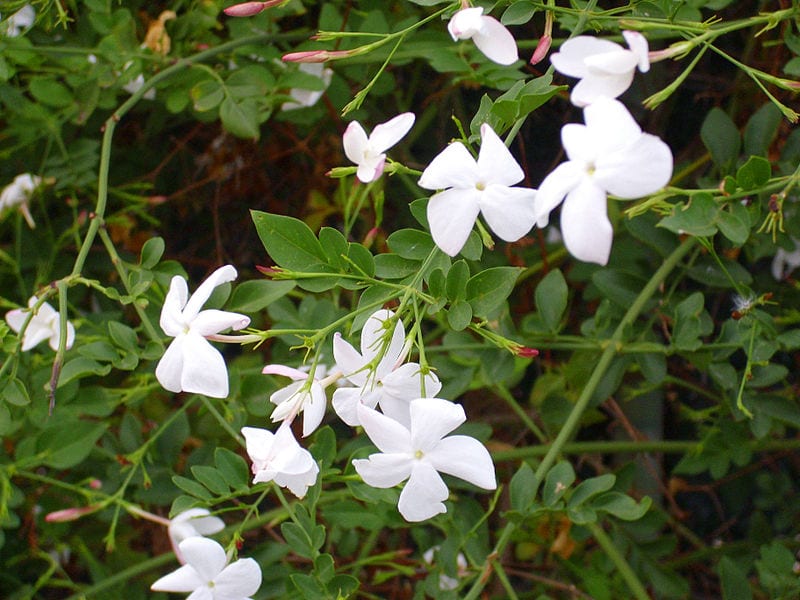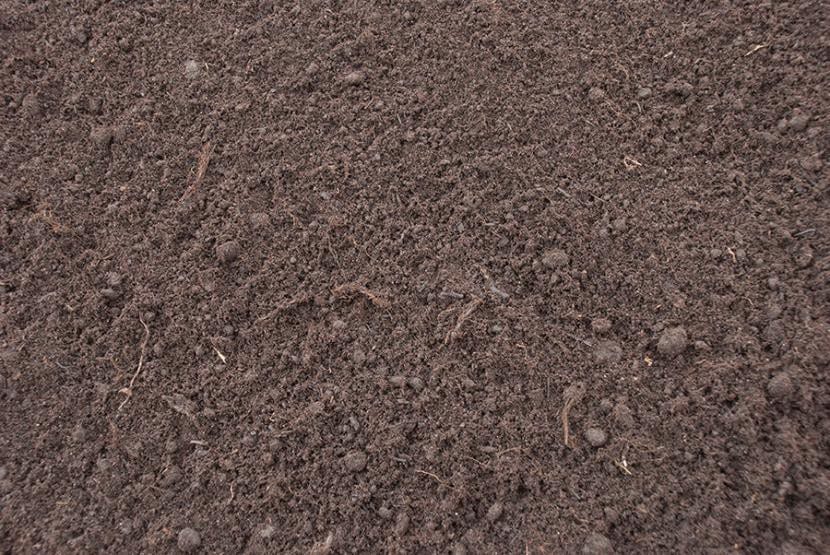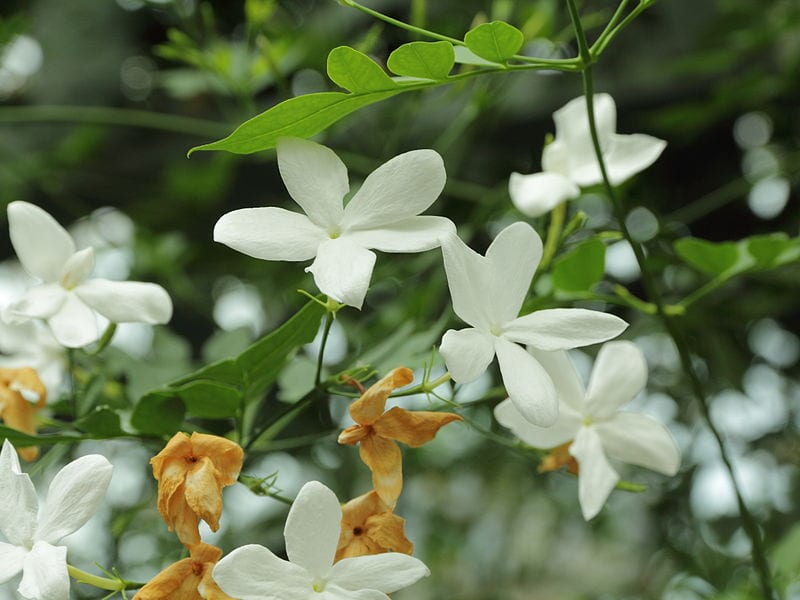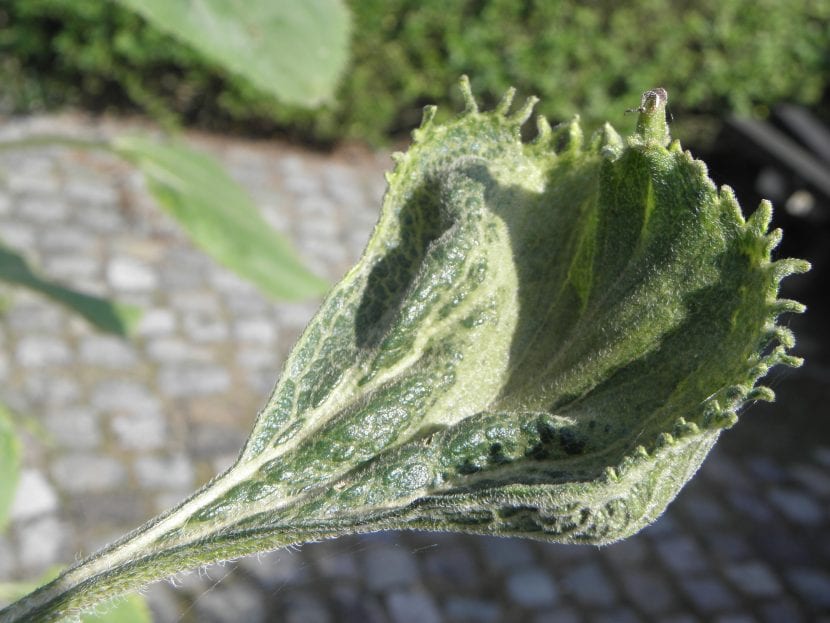
El Jasminum officinale she is a much loved climber. Its flowers are very small, barely 2cm in diameter, but they are so beautiful and emit such a pleasant aroma that it is a pleasure to approach them. In addition, its cultivation is so simple that it will not matter if it is in a pot or in the garden.
But if you want to know how to enjoy your plant to the fullest and / or if you want to be able to show it off every time you have visitors, you can't miss this special.
Origin and characteristics

Our protagonist is an evergreen climbing plant -that is, it remains evergreen- native to the Caucasus, northern Iran, Afghanistan, Pakistan, the Himalayas, India, Nepal and western China. It is popularly known by the names of common jasmine, Moorish jasmine, white jasmine, summer jasmine, office jasmine or jasmine.
It grows to a height of six meters and has highly branched stems, slender, from which compound leaves of five to nine linear-lanceolate leaflets with the entire edge sprout. The flowers, which sprout in spring, are grouped in pure white inflorescences and are hermaphroditic. Once they are pollinated, the fruit is formed, which is a berry.
How do you take care of yourself?
If you want to have a jasmine in your home, we recommend that you provide it with the following care:
Location
You must place your plant outside, being very advisable in semi-shade although it can be in the sun.
Earth

- Flower pot: can grow in universal growing medium mixed with 30% perlite. You can buy the first one here and the second in this other link.
- Garden: it is not demanding at all. It grows in all types of soils, even limestone. Of course, if it has good drainage it will be easier to root.
Irrigation
Irrigation will depend on location, climate, and where it is planted, but In general, it will be watered 2-3 times a week in summer -something more if it is potted- and every 4-5 days the rest of the year.. In the case of having it in a container with a plate underneath, you must remember to remove the excess water ten minutes after watering.
Subscriber
During spring and summer it must be paid with organic fertilizersand guano or manure. If it is in a pot, it is important to fertilize with liquid fertilizers since this way the drainage will continue to be good.
Planting or transplanting time
Whether you want to plant your Jasminum officinale in the garden or pass it to a somewhat larger pot, you must do it at the end of winter, when temperatures start to rise above 15 degrees Celsius.
Pruning

Image - Wikimedia / CT Johansson
In the winter dry, diseased or weak branches must be removed, as well as those that cross giving it a matted appearance.
Multiplication
Multiply by leafy semi-woody cuttings in late summer. You just have to cut them, impregnate the base with homemade rooting agents and plant them in a pot with vermiculite (you can buy it here). After about two to three weeks they will begin to emit roots.
Pests
El Jasminum officinale can be affected by the following pests:
- Borers: Hylesinus larvae excavate galleries between the bark and the wood. With the naked eye you can see holes through which the adult specimens come out, which must be fought with insecticides for larvae.
- Mealybugs: either cottony or limpet, they adhere to the leaves to feed on them. To control or combat them you can use diatomaceous earth (you can buy it here), neem oil (get it here) or potassium soap (in this link you can buy it).
- Weevils: those of the genus Otiorrhynchus bite the edges of the leaves. They are fought with chlorinated insecticides.
- Jasmine Piral: they are caterpillars of the Margaronia or Glyphodes species that feed on the most tender leaves protected with silk threads that they themselves manufacture. They are fought with an anti-caterpillar insecticide.
- Trunk drill: the caterpillars of the butterfly Zeuzera pyrina open galleries in the trunk of about 1 centimeter in diameter. They are fought with insecticides that act by inhalation.
Management

Leaf of a plant with downy mildew.
You can have the following diseases:
- Neck guts: tumors appear at the base of the trunk produced by Agrobacterium tumefaciens. There is no treatment.
- Leaf spots: Ocher colored spots may sometimes appear on the leaves. To prevent the situation from getting worse, it is recommended to treat Jasminum officinale with fungicides such as Zineb or Mancozeb.
- Mildew: a gray powder or mold appears on the leaves, especially in the younger ones. There may also be brown spots on the branches. It is fought with fungicides.
- Root rot: occurs when the plant has been in very humid soils (or substrates). Fungi, such as Phytopthora, appear and weaken it even more. To avoid losing it, it is necessary to treat it with fungicide and reduce the risks.
- Tuberculosis: tumors or warts appear on the branches produced by the bacterium Pseudomonas savastanoi. There is no treatment.
Rusticity
Withstands frosts up to -5ºC.
What did you think of the Jasminum officinale? Its nice is not it?
Very interesting all your posts. One doubt: I have that blank jasmine, it has given seeds and a little jasmine recently came out, without having sown it, but with yellow flowers, could it be that it has been crossed with another species?
Hello Fernando.
I am more inclined to think that some bird brought some seed to your home and it germinated 🙂
A greeting.
My jasmine has something sticky and white. I saw it with a magnifying glass and there are little cats ... what plague is it? Thank you!!! I am giving?
Hello Maria Inés.
From what you count, they seem cottony mealybugs. You can remove them with a small brush soaked in water and pharmacy alcohol.
Regards!
Hello, I live in an area of the Argentine Atlantic coast, I have a jasmine climbed to a column of light in the garden and I want to transplant it to the sidewalk, it is also dirt and grass, it is about 2 meters, in what month should I do it? August? survive to?
Hi Anabella.
We recommend transplanting it in late winter or early spring 🙂
You have to try not to manipulate its roots too much, that is why you have to make deep trenches - about 40cm - around the plant to be able to remove it with a good soil / root ball bread.
If you have questions, contact us.
Greetings.